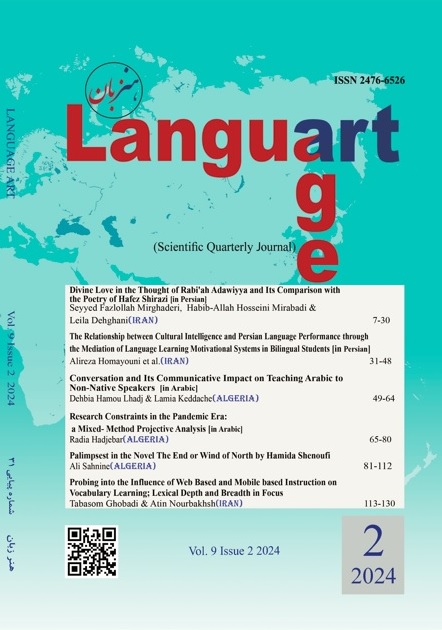Divine Love in the Thought of Rabi'ah Adawiyya and Its Comparison with the Poetry of Hafez Shirazi
DOI:
https://doi.org/10.22046/LA.2024.07Keywords:
Hafez Shirazi, Rabi'ah Adawiyya, Divine LoveAbstract
At a time when asceticism was the dominant approach among mystics, Rabi'ah Adawiyya introduced the concept of divine love and mystical devotion. In the centuries following Rabia, divine love remained one of the most fundamental themes in the works of Persian mystical poets. This research explores the prominent aspects of Rabia’s mystical love through an investigative lens and then compares them with the poetry of Khwaja Hafez Shirazi, identifying their similarities. The study adopts a qualitative approach, relying on descriptive-analytical and comparative methods. The comparative framework is based on the American school of comparative literature, which emphasizes parallels and affinities. The findings reveal that the key characteristics of Rabia’s mysticism include: “Pure love”, “Beholding the Beloved’s beauty”, “Not diverting from the Creator to the creation”, “Preferring the Friend over the world and its people”, “Night vigils and devotion”, “Weeping in separation from the Beloved”, “The lover’s immersion in the Beloved”, “The station of intimate friendship” (Khalwat), these elements can also be observed in Hafez’s poetry. Although Hafez expresses these concepts in a more eloquent and captivating manner, their origins can be traced back to Rabia’s thought.
References
آبراهموف، بنیامین (1388). عشق الهی در عرفان اسلامی. ترجمه حمیرا ارسنجانی. تهران: نشر نگاه معاصر.
ابراهیمی دینانی، غلامحسین (1389). دفتر عقل و آیت عشق. تهران: طرح نو.
بدوی، عبدالرحمن (1367). شهید عشق الهی رابعه عدویه. ترجمه محمد تحریرچی. تهران: مولی.
پورنامداریان، ت. (1394). دیدار با سیمرغ. چاپ ششم. تهران: پژوهشگاه علوم انسانی و مطالعات فرهنگی.
رادفر، ابوالقاسم (1382). آن نایب مریم صفیه، آن مقبول رجال، رابعه عدویه. مجله فرهنگ، شماره 48، زمستان 1382، صص 19-3.
رازی، نجم الدین (1365). مرصاد العباد. تصحیح محمد امین ریاحی. تهران: انتشارات علمی و فرهنگی.
رحیمیان، سعید و سیدفضلالله میرقادری (1391). روایع من نصوص العرفانیه. شیراز: انتشارات دانشگاه شیراز.
ستاری، جلال (1374). عشق صوفیانه. تهران: نشر مرکز.
سرامی، قدمعلی و مهری تلخابی (1389). رابعه در گذر از پل مجاز. مجله ادبیات عرفانی و اسطوره شناسی، بهار 1389، شماره 18، صص 104-81.
کاشانیها، زهرا (1382). رابعه عدویه. تهران: موسسه فرهنگی نشر رامین.
عطار نیشابوری، فریدالدین (1366). تذکره الاولیا. به تصحیح محمد استعلامی. تهران: زوار.
مکی، ابوطالب (2001). قوت القلوب. به تصحیح محمود ابراهیم محمد رضوانی. قاهره: دارالتراث.
نیری، محمد یوسف (1392). نرگس عاشقان. شیراز: انتشارات دانشگاه شیراز.
همتی، منا (1388). جایگاه رابعه عدویه در آثار منظوم و منثور صوفیه. پایان نامه برای اخذ درجه کارشناسی ارشد. دانشگاه ارومیه، زمستان 1388.
Abrahmov, Benjamin (2009). Divine love in Islamic mysticism [‘Eshgh-e elahi dar erfan-e eslami]. (H. Arsanjani, Trans.). Tehran: Naghsh-e Moaser.
Ebrahimi Dinani, Gholamhossein (2010). The notebook of reason and the sign of love [Daftar-e aghl va ayat-e eshgh]. Tehran: Tarh-e No.
Badawi, Abd al-Rahman (1988). The martyr of divine love: Rabia al-Adawiyya [Shahid-e eshgh-e elahi: Rabia Adawiyya]. (M. Tahrirchi, Trans.). Tehran: Mowla.
Pournamdarian, T. (2015). Encounter with the Simurgh [Didar ba Simorgh] (6th ed.). Tehran: Institute for Humanities and Cultural Studies.
Radfar, Abolghasem (2003). "That deputy of Maryam Safiyya, that accepted among men, Rabia al-Adawiyya" ["An na’ib-e Maryam Safiyya, an maqbul-e rejal, Rabia Adawiyya"]. Farhang Journal, 48, 3-19.
Razi, Najm al-Din (1986). The path of God's servants [Mersad al-ebad]. (M. A. Riyahi, Ed.). Tehran: Elmi Farhangi Publications.
Rahimian, Saeed & Mirghaderi, Seyyed Fazlollah (2012). Excerpts from mystical texts [Rava’e’ men nosus al-erfaniyya]. Shiraz: Shiraz University Press.
Sattari, Jalal (1995). Sufi love [Eshgh-e Sufiyane]. Tehran: Markaz Publishing.
Sarami, Ghadamali & Talkhabi, Mehri (2010). "Rabia in the passage from the bridge of metaphor" ["Rabia dar gozar az pol-e majaz"]. Journal of Mystical Literature and Mythology, 18, 81-104.
Kashaniha, Zahra (2003). Rabia al-Adawiyya. Tehran: Ramin Cultural Institute.
Attar Neyshaburi, Farid al-Din (1987). Memorial of the saints [Tazkirat al-awliya]. (M. Estelami, Ed.). Tehran: Zavar.
Makki, Abu Talib (2001). The nourishment of hearts [Qut al-qulub]. (M. I. M. Radwani, Ed.). Cairo: Dar al-Turath.
Neyri, Mohammad Yusef (2013). The narcissus of lovers [Narges-e asheghan]. Shiraz: Shiraz University Press.
Hemmati, Mona (2009). The position of Rabia al-Adawiyya in Sufi prose and poetry [Jāygāh-e Rābia Adawiyya dar āthār-e manzum va mansur-e Sufiyya] [Master’s thesis]. Urmia University.
Downloads
Published
How to Cite
Issue
Section
License
Copyright (c) 2024 Seyyed Fazlollah Mirghaderi, Habibollah Hosseini Mirabadi, Leila Dehghani

This work is licensed under a Creative Commons Attribution 4.0 International License.

